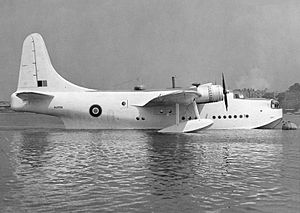Short Seaford
| S.45 Seaford | |
|---|---|
 |
|
| Seaford NJ205 at Rochester, July 1946 | |
| Role | Flying boat |
| National origin | United Kingdom |
| Manufacturer | Short Brothers |
| First flight | 30 August 1944 |
| Primary user | Royal Air Force |
| Number built | 10 |
| Developed from | Short Sunderland |
| Variants | Short Solent |
The Short S.45 Seaford was a 1940s flying boat, designed as a long range maritime patrol bomber for RAF Coastal Command. It was developed from the Short S.25 Sunderland, and initially ordered as "Sunderland Mark IV".
In 1942, the Air Ministry issued Specification R.8/42 for a replacement of the Sunderland, as a long range patrol bomber for service in the Pacific Ocean. It required more powerful engines, better defensive armament, and other enhancements.
The Sunderland Mark IV used major structural elements of the Sunderland Mark III, with a fuselage stretch of 3 ft ahead of the wing, an extended and redesigned planing bottom, the same wing with thicker Duralumin skinning, and Bristol Hercules engines. Further structural changes were made after initial flight tests. The planned armament consisted of two fixed forward-firing .303 inch (7.7 mm) Browning machine guns in the nose, a Brockhouse Engineering nose turret with twin .50 in (12.7 mm) machine guns, twin 20 mm Hispano cannon mounted in a Bristol B.17 dorsal turret, twin .50 in (12.7 mm) guns in a Glenn-Martin tail turret, and another .50 in (12.7 mm) machine gun in a hand-held position on each side of the fuselage. The turrets were all electrically powered. Two prototypes and thirty production aircraft were ordered as the Sunderland Mark IV.
On 30 August 1944, the prototype (MZ269) first flew from the River Medway at Rochester. The increased engine power caused aerodynamic stability problems, and a new fin was designed with greater height with forward dorsal extension, plus a new tailplane with increased span and area. Changes were so extensive, that the new aircraft was given the name Seaford. Thirty production aircraft were ordered, but the first of these flew in April 1945, well after the introduction of the Sunderland Mark V, and too late to see combat in Europe. The prototypes were powered by Hercules XVII engines of 1,680 hp (1,253 kW), but production aircraft used 1,720 hp (1,283 kW) Hercules XIX engines. The planned Glenn Martin tail turrets were never installed. Eight production Seafords were completed; the first (NJ200) was used for trials at MAEE Felixstowe. The second production Seaford (NJ201) was evaluated by RAF Transport Command, then in December 1945 it was loaned without armament to BOAC as G-AGWU, then returned to MAEE as NJ201 in February 1946. In April 1946, the other six production Seafords were delivered to No. 201 Squadron RAF for brief operational trials. In 1948, those six aircraft were modified as civilian airliners at Belfast, then leased to BOAC with the designation Solent 3.
...
Wikipedia
